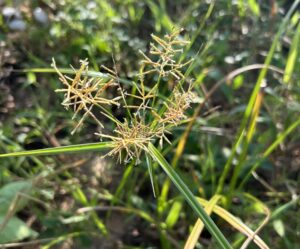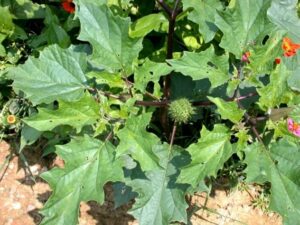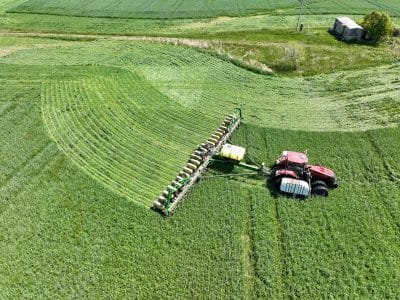Solanum carolinense L.
Also known as wild potato, sand brier
Note: This information is based on experience in the Mid-Atlantic state; recommendations in other regions may vary.
Carolina horsenettle is a perennial species from the Solanaceae family (nightshade). New plants emerge readily from seeds as well as creeping rootstocks. It tolerates a wide range of soil conditions, including eroded soils. It is often found in overgrazed pastures. The berries are often harvested with soybeans and small berries can be difficult to separate from the grain.
Identifying Features
Horsenettle stems and leaves have short, stiff spines. In addition to weed competition, horsenettle affects crop production since its berries are harvested with soybeans and processing vegetables and are difficult to physically separate. Horsenettle plants can be poisonous to animals at high concentrations.

Seed Production
Horsenettle berries contain up to 150 seeds with a single shoot producing up to 5,000 seeds. Seedlings can emerge from plants buried 2 inches deep. Plants emerging from seeds can produce creeping rootstocks within 1 to 2 months. Mature plants arise from thick, deep, horizontal creeping roots. The taproot can grow 4 feet deep; and horizontal roots can spread more than 3 feet per year.

Herbicide-Resistance
None reported.
Management
Plants emerging from seeds are controlled with most triazine herbicides (simazine, atrazine, and metribuzin) applied at planting. Plants emerging from overwintering rootstocks are difficult to control. Postemergence applications of glyphosate, Liberty, atrazine, dicamba, or aminopyralid are effective to varying degrees. Burndown treatments of glyphosate or paraquat in the spring will control the emerged portion of the plant, but additional shoots are likely to emerge. The best time to treat it is in the late summer or early fall with glyphosate or dicamba. This species is sensitive to frost, so applications should be made about 2 weeks before a killing frost. Plants damaged by harvest should be allowed time to recover before treatment. Due to the extensive horsenettle root system, 2 to 3 years of consistent management is needed to significantly reduce horsenettle shoots.
Corn
Soil application of atrazine or simazine at planting are effective for plants emerging from seed. Postemergence applications of glyphosate (in Roundup Ready corn), glufosinate (Liberty; in LibertyLink corn), dicamba, or dicamba plus a Group 2 herbicide (halosulfuron, nicosulfuron, primisulfuron) in early June will provide fair to good control for that cropping season but have minimal impact on long-term management of this species. Fields should be treated after harvest and when horsenettle plants are actively growing. Plants damaged by harvest should be allowed time to recover before treating; thus, keeping the combine header as high as possible will result in quicker horsenettle plant recovery. Wait 7 to 10 days after herbicide application before the field is tilled or mowed.
Sorghum
Soil application of atrazine at planting is effective for seed-ling control, and a postemergence application of dicamba or dicamba plus halosulfuron is effective for suppression of emerged plants. Fields should be treated after harvest and while the horsenettle plants are actively growing. Plants damaged by harvest should be allowed time to recover before treating; thus, keeping the combine header as high as possible will result in quicker horsenettle plant recovery. Wait 7 to 10 days after herbicide application before the field is tilled or mowed.
Soybean
Soil application of metribuzin at planting is effective for plants emerging from seed. Postemergence applications of glyphosate (Roundup Ready corn), glufosinate (Liberty in LibertyLink soybean), or dicamba (Engenia or XtendiMax in Xtend soybean) are effective to control emerged plants. Classic, Pursuit, and Synchrony can provide some suppression. Since soybeans are harvested late in the fall and all of the horsenettle leaves are removed during harvest, postharvest applications are not practical. Glyphosate applications as part of a harvest aid will be of limited benefit due to horsenettle senescence and lower glyphosate rate.
Small Grains
Horsenettle typically does not interfere with small grain due to differences in growth cycles.
Perennial Forages
Grass hay crops should be treated after the last cutting of the year, after allowing horsenettle to recover, but before the forages interfere with spray coverage. Dicamba, aminopyralid, and picloram, in labeled crops and states, provide the most consistent control. Roundup Ready alfalfa can be treated with glyphosate. Spot treatments of glyphosate is the best option for conventional alfalfa, or dicamba in a mixed stand to allow the forage grasses to survive.
This content was presented in the “Mid-Atlantic Field Crop Weed Management Guide” (2020), Penn State Ag Communications, AGRS-136

































































































